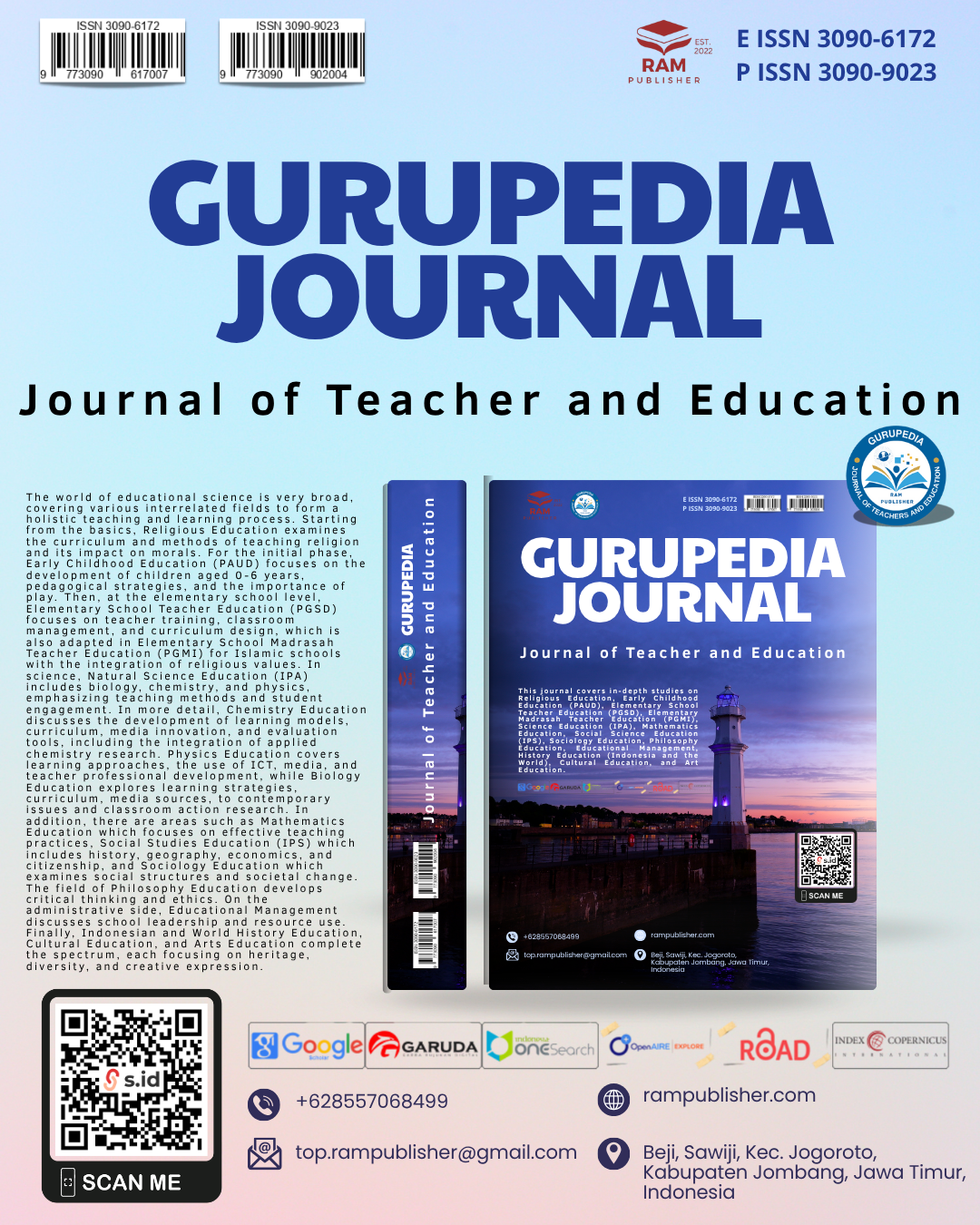The Basic Concept of Sufism Morals as the Initial Step in Purifying the Souls of Students
DOI:
https://doi.org/10.5281/zenodo.17092122Keywords:
Morals, Sufism, Tazkiyah al-Nafs, Santri, Character EducationAbstract
Sufism is a branch of Islamic knowledge that focuses on the spiritual dimension and purification of the soul (tazkiyah al-nafs). In Islamic boarding school education, Sufism plays a crucial role in shaping the character of students with noble morals. This article examines the basic concepts of Sufism morals and their relevance to the process of purifying the soul, encompassing values such as sincerity, patience, asceticism, and contentment. This research used a descriptive qualitative literature study method. The results indicate that the stages of takhalli (emptying oneself of blameworthy traits), tahalli (filling oneself with praiseworthy traits), and tajalli (revealing Divine truth) are the main foundations in the process of purifying the soul. The implementation of these values is not only relevant for the formation of insan kamil (perfect human beings) in Islamic boarding schools but also holds high relevance in the modern era for character education, self-control, mental health, and social ethics. Overall, Sufism morals are a transformative approach to building spiritual depth amidst the challenges of a fast-paced and materialistic life.
Downloads
References
Al-Ghazali, A. H. M. Ihya’ ‘Ulum al-Din. Dar al-Fikr.
Al-Qushayri, A. Q. A. K. (2007). *Risalah Qusyairiyah*. Pustaka Amani.
Arifin, Z., Rusly, F., & Islam, S. (2025). Implementasi nilai-nilai tasawuf bagi santri dalam menghadapi era globalisasi di pondok pesantren. *Jurnal Al-Fatih, 8*(1), 55–70. https://doi.org/10.61082/alfatih.v8i1.502
Aziz, F., Jumari, & Salim, M. N. (2023). Implementasi nilai-nilai tasawuf dalam membentuk karakter santri di era globalisasi di Pondok Pesantren Majma’al Bahroin Hubbul Wathon Minal Iman Losari Ploso Jombang. NELITI. https://media.neliti.com/media/publications/583286-implementasi-nilai-nilai-tasawuf-dalam-m-fda5b4b5.pdf
Braun, V., & Clarke, V. (2006). Using thematic analysis in psychology. *Qualitative Research in Psychology, 3*(2), 77–101. https://doi.org/10.1191/1478088706qp063oa
Fitriya, E., Hani’ah, N., & Khofifah, H. (2024). Tasawuf dalam perspektif psikologi: Harmoni spiritual dan kesehatan mental. *Alhikam Journal of Multidisciplinary Islamic Education, 5*(2), 233–250. https://e-journal.staima-alhikam.ac.id/ajmie/article/download/3079/1041/8333
Krippendorff, K. (2022). *Content analysis: An introduction to its methodology* (4th ed.). SAGE. https://methods.sagepub.com/book/mono/preview/content-analysis-4e.pdf
Lincoln, Y. S., & Guba, E. G. (1985). *Naturalistic inquiry*. SAGE. https://archive.org/details/naturalisticinqu00linc
Mukhlisin, & Purnomo, S. A. (2023). Relevansi akhlak tasawuf dalam pendidikan abad 21: Antara teori dan praktik. *Jurnal Al-Asma*, 12(1), 45–60. https://jurnalstitmaa.org/index.php/alasma/article/download/122/106/228
Nasution, H. (1973). *Falsafat dan mistisisme dalam Islam*. Bulan Bintang.
Page, M. J., McKenzie, J. E., Bossuyt, P. M., Boutron, I., Hoffmann, T. C., Mulrow, C. D., … Moher, D. (2021). The PRISMA 2020 statement: An updated guideline for reporting systematic reviews. *BMJ, 372*, n71. https://doi.org/10.1136/bmj.n71
Saprin. (2019). Tasawuf sebagai etika pembebasan; memosisikan Islam sebagai agama moralitas. *Jurnal Etika Islam, 7*(1), 15–30. https://media.neliti.com/media/publications/285388-tasawuf-sebagai-etika-pembebasan-memosis-90160c98.pdf
Snyder, H. (2019). Literature review as a research methodology: An overview and guidelines. *Journal of Business Research, 104*, 333–339. https://doi.org/10.1016/j.jbusres.2019.07.039
Downloads
Published
Issue
Section
License
Copyright (c) 2025 Khoirul Anwar (Author)

This work is licensed under a Creative Commons Attribution 4.0 International License.
How to Cite
Similar Articles
- Nur Ismianah, Muhammad Amanulloh Mz, Education Policy 2025: Between Hope, Reality and Implementation , GURUPEDIA: Journal of Teacher and Education: Vol. 1 No. 1: January 2025
- Alingka Fahada Firmatasya, M. Mafatihul Falah Mz, Muhammad Amanulloh Mz, Nur Ismianah Mz, Education, Business, and Information Technology: Building Innovative Ecosystems in the Midst of Disruption , GURUPEDIA: Journal of Teacher and Education: Vol. 1 No. 1: January 2025
- Arditya Prayogi, Riki Nasrullah, Singgih Setiawan, M. Adin Setyawan, Mohammad Syaifuddin, Supervisi Akademik dan Kepemimpinan Pendidikan dalam Meningkatkan Profesionalisme Guru: Analisis dan Refleksi atas PERMENPAN 21/2024 , GURUPEDIA: Journal of Teacher and Education: Vol. 1 No. 1: January 2025
- Dewi Wulandari, Annisa Shofiya Kamila, Dyah Octaviana Wahyuningrum, Muhammad Shohibul Mafariech, Implementasi Program Keagamaan “Pejuang Al-Qur’an” Dalam Membentuk Karakter Religius Di Stit Urwatul Wutsqo Jombang , GURUPEDIA: Journal of Teacher and Education: Vol. 1 No. 1: January 2025
- Patria Adiguna, Metodologi Penelitian Dalam Penulisan Skripsi dan Tesis , GURUPEDIA: Journal of Teacher and Education: Vol. 1 No. 2 (2025): July 2025
- Muhamad Syafiq Yunensa, Kusnul Agustin, Internalisasi Karakter Toleransi Beragama di Gusdurian UIN Walisongo , GURUPEDIA: Journal of Teacher and Education: Vol. 1 No. 2 (2025): July 2025
- Arditya Prayogi, Riki Nasrullah, Mohammad Syaifuddin, Qurrota A'yun, Optimalisasi Pembelajaran Global melalui Video Game: Potensi dan Tantangan dalam Konteks Pendidikan Indonesia , GURUPEDIA: Journal of Teacher and Education: Vol. 1 No. 2 (2025): July 2025
- Inzalul Akhyar, Aep Saefullah, Literatur Review Eksplorasi Budaya Organisasi KMIK Jakarta dalam Mewujudkan Nilai Keislaman, Keilmuan, dan Kekeluargaan , GURUPEDIA: Journal of Teacher and Education: Vol. 1 No. 2 (2025): July 2025
- Achmad Aprelio Adha, Prof. Dr. Muslimin Machmud, M.Si, Assc. Prof. Dr. Saiman, M.Si., The Meaning of Practicing Compassion and Social SolidaritySerat Driyabrata , GURUPEDIA: Journal of Teacher and Education: Vol. 1 No. 2 (2025): July 2025
You may also start an advanced similarity search for this article.





